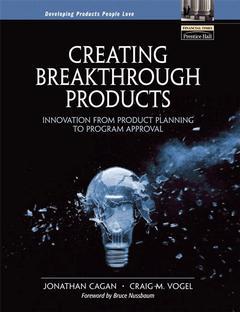Creating breakthrough products: innovation from product planning to program approval
Auteurs : CAGAN, VOGEL GODERICH Peter

The complete guide to developing tomorrows most successful innovations!
- Social, economic, and technological forces that create breakthrough opportunities.
- Managing the "fuzzy front end" of product development -- when products and markets arent yet defined.
- Identifying value-adds based on emotion, aesthetics, identity, ergonomics, impact, technology, and quality -- and translating them into real products, features, and styles.
Jonathan Cagan is Professor of Mechanical Engineering and Computer Science at Carnegie Mellon University, specializing in research concerning early product design, optimization, artificial intelligence, and product development. Craig M. Vogel, Associate Dean of the School of Fine Arts and Professor in the School of Design at Carnegie Mellon University in Pittsburgh, chairs the board of the 2,900-member Industrial Designers Society of America (IDSA), and is a board member for the WORLDESIGN Foundation.
2. Moving to the Upper Right.
3. The Upper Right: The Value Quadrant.
4. The Core of a Successful Brand Strategy: Breakthrough Products and Services.
5. A Comprehensive Approach to User-Centered, Integrated New Product Development.
6. Integrating Disciplines and Managing Diverse Teams.
7. Understanding the Users Needs, Wants, and Desires.
8. Case Studies: The Power of the Upper Right.
9. Automotive Design: Product Differentiation through User-Centered iNPD.
Research Acknowledgments.
Epilogue.
Future Trends.
Have Faith in the Leap.
References.
Index.
- Techniques for identifying breakthrough opportunities Exclusive new analysis techniques draw upon deep insight into social, economic, and technological forces to identify opportunities for extraordinary success, e.g., Sony Walkman.
- Helps students become far more effective in identifying significant market opportunities.
- Todays seven most important value-adds Identifies and illuminates seven key opportunities to add value: emotion, aesthetics, identity, ergonomics, impact, technology, and quality.
- Helps students quickly and systematically determine how their products or services will differentiate themselves.
- Extensive case study focus Presents in-depth case studies of more than a dozen of todays most important product and ser
Date de parution : 10-2001
Ouvrage de 314 p.
23.5x18.4 cm



